A double cross is when you are aimed one way to hit a draw or a fade and you actually hit the opposite shot. For example, if you are set up aiming slightly left and then hit a draw or you are set up to hit a draw and you hit a fade. The negative of this shot is that you end up way off of the target line and a bogey or higher is almost guaranteed!
We know the feeling! You are standing on the tee box ready to hit your driver and you have no idea where the ball is going.
You stand there and worry about a double cross in your golf swing.
You think if everything works out just fine the ball will fade or draw back into the middle of the fairway!
Regardless if you normally hit a draw or fade in golf, we all worry about the double cross at different times. The key to solving this issue is creating a stock shot that you can rely on.
Below, we will provide an overview of the double cross and what steps you can take to eliminate the double cross in golf from your golf swing to free you up to play the course and manage your game!

What Is A Double Cross in Golf? (Eliminate this shot!)
Below we will dive into this topic and help you understand the causes and the fixes and ultimately help you develop a stock shot.
- What causes the double cross in golf
- How to fix the double cross in golf
- How to build a stock shot
- How to measure your swing
- BONUS TIP: How to gain 5-8% in swing speed
What Causes the Double Cross in Golf?
Cause #1: The club face and swing path are not properly aligned
We are fortunate to live in an era where we can understand the ball flight laws. Technically speaking, what causes the double cross in golf is when you are aimed left and your path and club face are both left, but the club face is even further left than the path.
Or on the opposite side, when you are airming right and your path and club face are both right, but the club face is even further right than the path.
Keep in mind that the ball will start relative to the direction that face is pointing at impact, so if the face is right the ball will start right, if the face is left the ball will start left. It will then curve away from the path. So the push right when you are trying to hit a draw is a result of the club face being right of the swing path. The all then start right and will fade or slice further right.
I know this can be confusing, but here is an overview of the ball flight laws with some examples.
Understanding The Ball Flight Laws
Why? If you understand the ball flight laws you can start to become your own swing instructor and make corrections on the range or the course by reading the flight of your golf ball.
Too often golfers turn to the video of their swing when everything you need to know can be read off of your ball flight. Did you know that your ball flight can tell you the following:
- Where your club face was at impact.
- If your swing path was left or right of the club face.
Once you know these two items you can make the corrections by checking out our 2nd Tip on understanding what swing thoughts can help you get the proper matchups.
So let’s dive into the ball flight laws:
- Generally speaking, the golf ball will start where the club face is aiming.
- The golf ball will then curve away from the swing path.
There are two different lines that we must understand. The target line and the start line. The best golfers start the ball left or right of the target line and then curve the ball back towards the target.
Let’s go over some examples to help you better understand the ball flight laws.
Example A: Let’s say that the club face is 3 degrees right of the target line and the swing path is 5 degrees right of the target line. What will the ball do?
Answer: The ball will start right of the target line and draw back towards the target. This is known as a push draw.
Example B: Let’s say the club face is 3 degrees right of the target line, same as in example A, but the swing path is only 1 degree right of the target line. What will the ball do?
Answer: The ball will start to the right of the target line and will fade to the right. Keep in mind that the ball will curve away from the swing path. In this example, both the club face and the swing path are to the right and the ball will curve away from the path.
Example C: Let’s say the club face is 3 degrees to the left of the target line and the swing path is 5 degrees left of the target line. What will the ball do?
Answer: The ball will start to the left and curve to the right. This would be a pull fade or pull slice. Keep in mind that even though the face is closed to the target line, it is open to the swing path and the ball will curve away from the swing path.
Example D: Let’s say the club face is 3 degrees to the left and the swing path is only 1 degree to the left. What will the ball do?
Answer: The ball will start left and curve left. This shot would look like a pull draw.
Hopefully, these examples help you understand the club face and swing path correlation and how they match up. Once you understand these ball flight laws, it will help you read your own shots and possibly make in round adjustments.
How to Fix the Double Cross in Golf
Fix #1: Develop a consistent club path and club face relationship
Ultimately, to hit a push draw you want a club face that is 1-3 degrees open to the target line with a path around 2-4 degrees right of the target line. This will produce a shot that stars to the right and curves back to the target.
There is a fine line because if the club face gets 5 degrees open it will start right and fade right if your path is only 2-4 degree right of the target line.
Conversely speaking, to hit a fade you want a club face that is 1-3 degrees closed to the target line with a path around 2-4 degrees left of the target line.
This will produce a shot that starts to the left and curves back towards the target. Once again, a fine line exists and if your club face gets too far left it will start left and curve left.
There are ways to build the stock shot and some great drills you can do to ensure you can rely on the consistent draw or fade.
How to Build A Stock Shot
A stock shot allows you to control your start line and your curve, which is the 2nd fundamental in golf (see fundamentals below). I would recommend the stock draw shot. Here is a drill you can practice at the driving range:
- Setup an alignment stick about 7 to 10 yards in front of you on the target line.
- See how many shots out of 10 you can start to the right of the target.
- Track this data over time and continue to work on your start line.
The goal here is to get the club face pointing in a similar direction as many times out of 10 as possible. Once we get the ball starting the right spot, we can then move onto the curve of the ball.
If your ball is starting to the right and curving to the right, let’s work on getting your swing path more to the right, which will then help you hit a draw.
Practice this every range session you have for at least 20-30 golf balls. Don’t just stand at the range and aimlessly hit golf balls. This drill can be a game changer for many golfers.
Fundamentals in Golf Swing
The Stack and Tilt Instructors said it best when they described what they believed were the fundamentals of golf. They explained it somewhat similar to this:
- Fundamental #1: The golfer’s ability to control the bottom of the golf swing. The best golfers will hit the ground in the intended spot, close to 100% of the time.
- Fundamental #2: The golfer’s ability to control the curve of the golf ball. The best golfers are able to start the ball to the right or left of the target line and have the ball curve towards the target without the ball over curving past the target.
- Fundamental #3: The golfer’s ability to have enough power to play the golf course. This means they are able to hit the ball far enough to play the course in regulation.
How To Measure Your Golf Swing
It can be helpful to know your swing path and club face direction at impact. In today’s golf world, even amateurs can have access to this technology and data with the technology now available.
The professional golfers of today all have access to some great technology including launch monitors to help measure their swing and know their numbers. Can an amateur use this same or similar technology for game improvement? Yes, absolutely and I would highly recommend it.
Even if you aren’t going to go all out and build an indoor golf simulator like I did (see below), you can still pick up a launch monitor at a reasonable price and use it in your indoor net or taking to the course or driving range with you!
Know numbers like spin rate, ball speed, spin axis and other key information is vital to your growth. Sharing these numbers with your instructor can be helpful and help with equipment selection as well.
I would recommend one of the three launch monitors listed below:

BONUS TIP: How To Gain 5-8% in Swing Speed
Let’s face it, regardless of the current state of your game we all want more speed. It has become very clear the need for speed in the golf swing and there are ways to add speed! The analytics on all levels of golf show how important speed and additional speed are in reducing golf scores.
It is time to start training for some additional speed. This is a drill and training protocol that I would highly recommend.
SPEED DRILL: Increase your swing speed through overspeed training
- Check out SuperSpeed Overspeed Training Protocols
- Train every other day for 10-15 minutes.
- See a 4-6% increase in swing speed as early as the first training protocol.
The number one thing that has helped me gain significant distance is the SuperSpeed Training System. This overspeed based system where you train every other day for about 10-15 minutes with different swing sticks can help you increase your swing speed by 5-8% which can be 20-30 yards. Who wouldn’t want an extra 20-30 yards. Plus it helps improve your mechanics.
SuperSpeed Golf – Use Discount Code Golfjourney365 for some savings!
The analytics are pretty clear on the importance of speed in the game of golf. Would you rather hit your approach shot from 130 yards of 160 yards? The answer is pretty simple!
We know that over the course of time, we will hit shots from 130 yards much closer than from 160 yards, whether we are an average amateur golfer, a scratch golfer, or a PGA Tour member!
The key is having shorter approach shots, so we can hit the ball closer to the hole and then make more putts! Speed is king in the game of golf! Make sure you check out SuperSpeed Golf!
Final Thoughts: My Secret To Golf Improvement
The reality…in order to get really good at golf, we must practice frequently. About three years ago, I made the leap and invested in a golf simulator build for my garage.
I went with a SkyTrak Launch Monitor and the TGC software and can now play over 100,000 courses including Augusta, Pebble Beach, Bethpage Black, Whistling Straits. St. Andrews and many other of the top 100 courses in the world.
This golf simulator setup, which is more affordable that you might imagine, has been a game changer. I can now play golf everyday of the year regardless of rain, snow, cold weather or time of day. I can practice or play rounds of golf. I can stand in the 11th fairway at Augusta and with the auto-rewind feature I am able to practice my approach shots from various differences.
It is worth checking out through Rain or Shine Golf as they offer some incredible packages along with financing offers that are difficult to beat.
Some direct links to Rain or Shine Golf for pricing and financing:
Take Action – What You Can Do Today to Get Better
What does this mean for you? I believe in the following recipe to get better:
1 – Improve your motion in the golf swing by identifying a golf instructor. Here are some options:
Here is a list of golf instructors that we have reviewed:
2 – Train to swing faster and improve your swing speed. Here are some options:
Looking to gain more Speed and Distance in your swing. Two Options:
3 – Understand course strategy and work to break through your next barrier. Here is a series on breaking through:
We have provided guides on how to break 100, 90, 80 and 70. Check out more below, if interested.
4 – Practice Frequently
Did you know that I build a golf simulator in my garage and have played over 500 rounds of golf on my SkyTrak system? It has been a game changer and one worth checking out. Here are some of my other posts on golf simulators frequently asked questions:
- Is a Golf Simulator Worth It?
- How to Build a Golf Simulator?
- What is the Best Golf Simulator?
- Golf Simulator Accessories?
- How to Build a Golf Simulator for under $7000
- Top 11 Reasons to Buy a SkyTrak
- How to Build a Golf Simulator for Under $1000
- Why Build A Golf Simulator?
- What Space is Needed?
I am an amateur golfer on a journey to get better, enjoy the game as often as possible and share my passion and knowledge with others. I have coached high school golfers at a high level and have a great passion for the game and want to give back. I enjoy learning about the golf swing and am currently studying to be a certified professional golf instructor. Join me in our journey to get better everyday.

